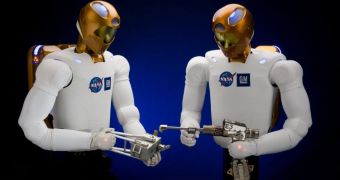Officials at the American space agency announce that the robotic astronauts they have been developing in cooperation with experts at General Motors is currently undergoing extensive testing. The machine is scheduled to fly to the International Space Station (ISS) this September, aboard the space shuttle Discovery, during the STS-133 mission. The new tool, called Robonaut 2, or R2 for short, is destined to assist astronauts in conducting their tasks, and also as a demonstrator for the new technologies its designers and builders placed inside.
The robot is planned to be used both for aiding space exploration, and for assisting on assembly lines at GM manufacturing plants. The assistant will become a permanent resident of the orbital facility, where its actions will be limited to the confines of the US-built Destiny Laboratory module. R2 weighs about 300 pounds (136 kilograms), and features a torso with two full arms and hands, as well as a head. It will be the job of the crew aboard the ISS to monitor the way this machines handles weightlessness and to assess whether such aids are fit for further use on the station and elsewhere.
Though current plans only see R2 working inside Destiny, scientists believe that improvements added over time could eventually allow for it to move more freely within the station, or maybe even on the outer hull of the structure. This could come in handy for assisting spacewalkers during tasks that require a lot of effort, which in turn could allow astronauts to focus more on the tasks at hand. The robot has been designed specifically to be tough, but also to interact with humans, and work side-by-side with them. It is also highly dexterous, which means it can perform about the same range of movements that humans can.
“This project exemplifies the promise that a future generation of robots can have both in space and on Earth, not as replacements for humans but as companions that can carry out key supporting roles. The combined potential of humans and robots is a perfect example of the sum equaling more than the parts. It will allow us to go farther and achieve more than we can probably even imagine today,” explains NASA official John Olson. He is the director of the agency's Exploration Systems Integration Office, which is based at the NASA Headquarters, in Washington, DC.
“The extreme levels of testing R2 has undergone as it prepares to venture to the International Space Station are on par with the validation our vehicles and components go through on the path to production. The work done by GM and NASA engineers also will help us validate manufacturing technologies that will improve the health and safety of our GM team members at our manufacturing plants throughout the world. Partnerships between organizations such as GM and NASA help ensure space exploration, road travel and manufacturing can become even safer in the future,” concludes GM global research and development vice president, Alan Taub.

 14 DAY TRIAL //
14 DAY TRIAL //